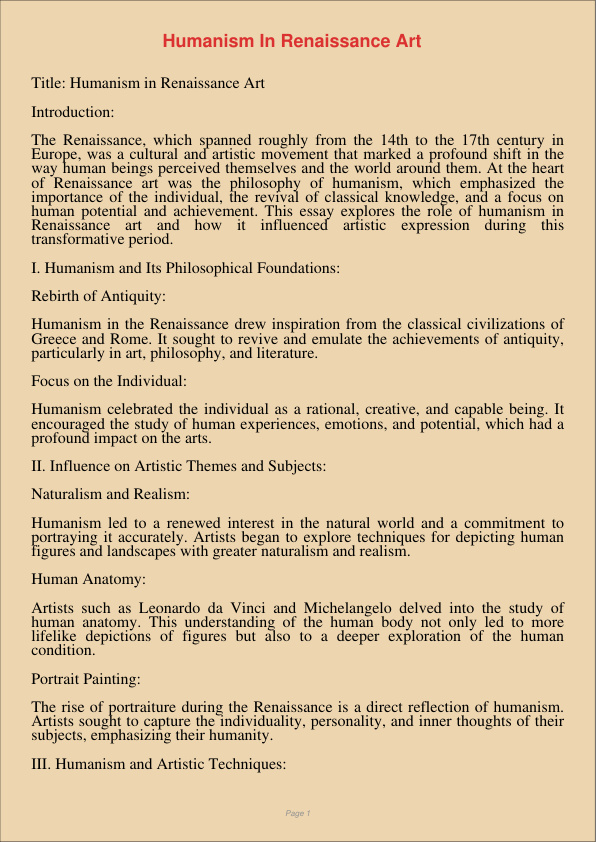Title: Humanism in Renaissance Art
Introduction:
The Renaissance, which spanned roughly from the 14th to the 17th century in Europe, was a cultural and artistic movement that marked a profound shift in the way human beings perceived themselves and the world around them. At the heart of Renaissance art was the philosophy of humanism, which emphasized the importance of the individual, the revival of classical knowledge, and a focus on human potential and achievement. This essay explores the role of humanism in Renaissance art and how it influenced artistic expression during this transformative period.
I. Humanism and Its Philosophical Foundations:
Rebirth of Antiquity:
Humanism in the Renaissance drew inspiration from the classical civilizations of Greece and Rome. It sought to revive and emulate the achievements of antiquity, particularly in art, philosophy, and literature.
Focus on the Individual:
Humanism celebrated the individual as a rational, creative, and capable being. It encouraged the study of human experiences, emotions, and potential, which had a profound impact on the arts.
II. Influence on Artistic Themes and Subjects:
Naturalism and Realism:
Humanism led to a renewed interest in the natural world and a commitment to portraying it accurately. Artists began to explore techniques for depicting human figures and landscapes with greater naturalism and realism.
Human Anatomy:
Artists such as Leonardo da Vinci and Michelangelo delved into the study of human anatomy. This understanding of the human body not only led to more lifelike depictions of figures but also to a deeper exploration of the human condition.
Portrait Painting:
The rise of portraiture during the Renaissance is a direct reflection of humanism. Artists sought to capture the individuality, personality, and inner thoughts of their subjects, emphasizing their humanity.
III. Humanism and Artistic Techniques:
Linear Perspective:
The development of linear perspective in painting, attributed to artists like Filippo Brunelleschi, allowed for the creation of three-dimensional, spatially accurate representations. This innovation was grounded in humanist ideas about understanding the physical world.
Chiaroscuro:
The use of chiaroscuro, the contrast between light and dark, was another technique refined during the Renaissance. It added depth, dimension, and emotional intensity to artworks, reinforcing the idea of capturing the complexity of human experience.
IV. Patronage and Artistic Freedom:
Support of Humanist Patrons:
Humanist scholars and patrons of the arts played a crucial role in promoting the ideals of humanism in Renaissance art. They provided funding and encouragement for artists to explore new ideas and themes.
Artistic Freedom and Expression:
Humanism’s emphasis on individuality and creativity allowed artists more freedom to express their unique visions. This led to a rich diversity of artistic styles and approaches during the Renaissance.
Conclusion:
Humanism was a foundational and transformative force in Renaissance art, reshaping the way artists depicted the world and the human experience. It championed the individual, celebrated the revival of classical knowledge, and inspired artists to explore new techniques and themes. The impact of humanism on Renaissance art can still be seen and appreciated today, as it laid the groundwork for the continued exploration of human potential and expression in the arts.

「真诚赞赏,手留余香」
真诚赞赏,手留余香
使用微信扫描二维码完成支付
